Saturn cheer in late winter

It's easy to be a
cheerleader for Saturn:
...
Saturn live in a telescope eyepiece always impresses, no matter how many times you’ve seen it.
I’ve had folks who see Saturn for the first time sneak around to the end of my telescope thinking there must be some sort of viewer present there with a slide or videotape of Saturn’s image. They can’t believe the yellowish ball completely encircled by a large flat ring can be an actual object.
But that live image is real. Enough so that it’s hooked generations on amateur astronomy as a hobby. I’ve also heard from folks who say the ringed planet made them decide to bag the hobby, and this sometimes came after they had bought an expensive telescope. “After seeing Saturn, nothing else quite measured up,” they said.
...
Click through for additional info.
Bed & Breakfast focused on wildlife watching
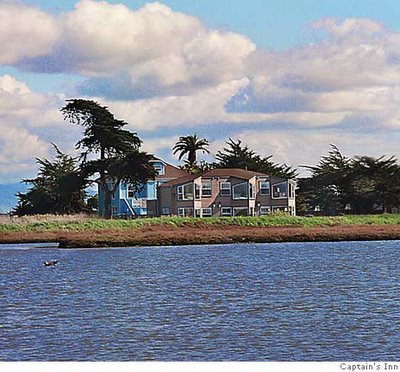

Now, for something 1/2 hour from Tako John, a
B&B that provides binoculars to guests for the wonderful wildlife watching nearby. Don't expect to see any stars in the soupy fog belt of Moss Landing, maybe not even stuff 30 feet away. Also, don't expect a refined settlement, or much urban development, without driving 15-30 minutes. Elkhorn Slough is there for wildlife, there's fishing, a harbor, a large beach, a huge (ugly) power plant, and tourist restaurants.
For much of the past month between storms, Monterey Bay has looked something like Hawaii: azure water, foaming white surf, warm skies and views to forever. Whatever the weather, it would be hard to beat a hideaway at the Captain's Inn, a place that is still off the mainstream radar. It's a bed and breakfast in Moss Landing that opened three years ago, and it's not only a prime spot to hide out for a day or two but also a great launch point for adventure.
There's probably no other place like this anywhere. Much of the Captain's Inn has been renovated to look like a ship. Most of the rooms are in a separate structure with shore views.
You get the fluffy comforter and pillow treatment, but each room has an outdoors theme, like boating or fishing. Some of the beds are actually made from small boats.
Binoculars are provided with each room, the better to view sea otters, harbor seals and dozens of species of marine birds and waterfowl at Elkhorn Slough and the connected Elkhorn Slough National Estuarine Research Reserve.
This is also one of the best places in California to rent a kayak, and outstanding walking tours and overlooks are available within a short drive.
Artsy folks discover night vision
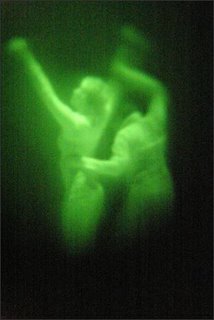
Creativity
shows no bounds, dancers in the dark with viewers wearing night vision goggles:
...
Big Brother merges with dance in "Dark Room," an aptly titled installation commissioned by Western Bridge art gallery and performed by the Crispin Spaeth Dance Group.
For 25 minutes, Spaeth asks her dancers to voluntarily give up their sight.
When the lights go out, the plunge into darkness is complete.
All they have is each other as they clutch hands, torsos and legs, using their bodies as their GPS.
Meanwhile, the audience surrounds them, 20 Peeping Toms armed with night-vision goggles trained on the five dancers and their nocturnal unrest.
...
This is open to loads of bad jokes.
Not a small scope...
This is just
too big to pass up:
A French astronomer has plans for a giant "hypertelescope" that could take pictures of forests and oceans on planets orbiting other suns.The massive Exo-Earth Imager, measuring over 60 miles across, would be large enough to spot a green patch the size of the Amazon on an alien world 10 light years away.
Dr Antoine Labeyrie, from the Observatory of Haute-Provence in southern France, is already testing the idea with a much smaller experimental telescope
Sky & Telescope Magazine Sold!
Big (bad?)
news out, which isn't much of a surprise considering how many paper magazines can't give themselves away these days. As much as I hate to see things like this happen, I'm much happier in a web world than the dead tree world.
The Sky & Telescope Is Falling As if the gutting of NASA's science programs weren't enough, astronomy aficionados have just taken another gunshot in the chest: Sky & Telescope magazine has been sold and, although the announcement doesn't mention it, a quarter of the staff has been laid off.
Sky & Tel is an institution -- the closest thing astronomy has to a magazine of record. I've known staffers there for over a decade and can say that, on topics ranging from DIY telescope building to Mars landers, they have a depth of knowledge and experience which simply can't be beat. They're the sort of people who'll go to an evening lecture and then stay up half the night writing about it, and rewriting, and rewriting -- until they find the best way to explain the subject to the interested layperson. People subscribe to the magazine their whole lives; they are not mere consumers but members of a community. I hope the survivors of this purge can keep things going. The world would be a much poorer place without it.
I don't know the details of Sky & Tel's travails, but presumably declining advertising revenues have something to do with it. Magazines in general, and science magazines in particular, also have to struggle with the tragedy of the Internet commons. Sky & Tel, like us, puts material on the web for free, which undermines our own business. None of us gets rich working at a magazine; we do it because we love science and want to help others understand it, too. How long that will last, if nobody can make a living at it, is unclear.
Digibinocing!
One person seems to have reinvented digiscoping with a pair of
binoculars:
As I was sitting at my desk, I noticed a crow sitting on my neighbours' house roof. The distance is about 20-30 meters. I know there's no way I could capture a shot of a crow with my 3x zoom Canon, so I took my old binoculars and placed it in front of the camera lens. After doing this I had to set my camera to macro mode, to get AF to focus correctly. Though, I had some troubles holding my binoculars still, if I would like to test more, I think I have to work out a tripod for binoculars, too.
The article has 3 large pics after the link. In my experience sometimes handheld shots are sharper than a more complex mount--details about my personal experiences digiscoping to come...when I have the time...
'Extinct' bird roundup
A fascinating
article on the potential rediscovery of the Ivory Billed Woodpecker discusses several other rediscovered birds:
Flying miracles
More supposedly extinct birds that have startled ornithologists
Berlepsch's six-wired bird of paradise (Parotia berlepschi) This species, previously only known from a few examples collected in the 19th century, made a dramatic reappearance in Papua New Guinea late last year.
Edward's pheasant (Lophura edwardsi) After last being seen in central Vietnam in 1928, it survived several wars and the scrutiny of half a dozen French expeditions before reappearing in 1998.
Indian forest owlet (Athene blewitti) If there was a prize for hiding from biologists, twitchers, collectors and tourists, this diminutive bird would surely win. In 1996, it was rediscovered after 113 years in hiding.
Chinese crested tern (Thalasseus bernsteini) Thought to have become extinct when specimen hunters killed 21 of them in 1938, four pairs popped up in 2001 on Taiwan's Matsu Island. It's hoped the presence of 18,000 troops and a missile base at its breeding ground will deter collectors this time around.
Aleutian Canada Goose (Branta canadensis leucopareia) In 1967, numbering fewer than 500, these birds were declared to be endangered. They then disappeared completely for 25 years but subsequently made a dramatic comeback, and now number some 40,000 animals.
Annual Great Backyard Bird Count this weekend
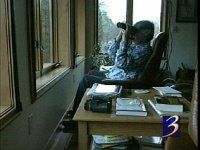 Announcement:
Announcement:
Bird watchers are dusting off their binoculars in anticipation of this weekend. More than 52,000 people are expected to take part in the annual Audubon Society Great Backyard Bird Count.
Volunteer watchers counted a record-breaking 613 species in 2005. This year, the information they collect could help scientists see how birds were affected by the recent hurricanes.
Camera Museum in South Africa (off topic)
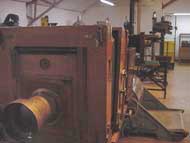
An
article by Lucille Davis on the City of Johannesburg website provides details about what seems to be one of the best photography museums in the world:
...
The museum has one of the world's best collections of photographic records and documents and, of course, cameras.
Donation
It was begun with a donation from amateur photographer and sometime Joburg mayor, Dr Arthur Bensusan, in 1968. He donated his entire 30-year collection: 400 antique cameras, 5 000 photographs and 2 000 photographic books, some of which date back to 1860. In November 1968 Bensusan told the Rand Daily Mail newspaper, "The museum will illustrate the history of photography and the history of South Africa as seen through the eye of the camera."
A number of these cameras are on display at the museum, making for a fascinating study. Part of Bensusan's original collection is a camera belonging to British statesman Winston Churchill, and perhaps the first official war photograph – one taken in 1854 of a Crimean War scene. Also in the collection are several spy cameras from the 1800s, made to look like watches, books and binoculars.
Besides collecting photography books, the museum continues to collect cuttings, pamphlets and journals, and has made some valuable additions to its wonderful collection.
First negative
The acquisition in 1970 of the first negative ever made is the most special of these. It was taken by the inventor of photography, William Fox Talbot, in 1835, with the help of a camera obscura. The negative, several centimetres in size, is of the oriel window of Lacock Abbey in England. The City bought it for R860, according to The Star of October 1970, acquiring it from Bensusan. There are only three other such negatives in the world – two in Britain and one in Russia.
...
Backyard observatories
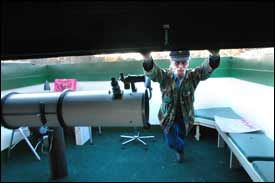
An article in the
Arizona Daily Sun describes some amazing backyard observatories. If only I didn't live in a mushy soup of ocean dampness...
Technology, Telescopes and Everything
The Desert Sun of Palm Springs discusses the application of computer technology to telescopes:
"Regular old dumb stuff is getting smart and connected.You can buy a backyard telescope loaded with global positioning satellite (GPS) technology so it can point out which stars you're viewing. At one university, each parking meter has a chip and antenna so you can call it with your cell phone and buy more time.
And then there are the touch-screen sewing machines that can download images to embroider, gas station pumps that run Microsoft Windows, and shipping crates that can call their owners for help if they're lost.
A lot of technology companies focus on making computers more powerful and Internet connections faster. But a major trend is pushing in another direction - toward getting cheap computer chips and limited networking capabilities into products that never used to have such technology. It lets companies turn commodity products into premium products that cost more and stand out in the marketplace.
The trend is analogous to the electrification of products 100 years ago, when inventors found ways to use that technology to change everyday items. Hand-turned drills became power drills. Ice boxes became refrigerators. The same thing is happening now, but with computer chips and tiny radio transmitters.
And there's a fascinating twist this time: When you add information and communications to a product, it doesn't just improve that product - it allows that product to become part of a network. Which means those products can talk to other products, or to Web sites, or to you through your cell phone or PC - creating layer upon layer of new possibilities.
"It opens up innovation to all new things no one ever thought of," says Irving Wladawsky-Berger, in charge of IBM's technical strategy.
"There's an interesting pattern now - everything is an accessory to everything else," notes Mick McManus, CEO of Maya Design.
The parking meters, for instance, are at the University of California, Santa Barbara. IBM devised the system and will try to sell it to other campuses and cities. In the near future, a "smart," networked parking meter might be able to talk to all the other parking meters in the neighborhood and feed that information to a Web site. That way, as you drive to an area looking for a place to park, your cell phone could tap the parking Web site and display a map showing open spaces.
Such a level of integration isn't here yet.
Still, the movement toward smart stuff keeps picking up steam. Companies are moving in that direction. A survey by research firm Aberdeen Group found that more than half of executives plan to pump more money into radio frequency identification (RFID) projects in the next 12 to 24 months."
Life is what you make it...
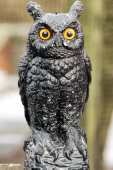
A story from
Manchester Online (UK) illustrates that some people are entrhalled by any wildlife:
One woman even spent five hours sitting in her back garden watching though binoculars, waiting for it to move. But what she and her neighbours didn't realise was that their rare visitor was, in fact, plastic and put there to scare other birds away.
It brings to mind the many times that hunters have "identified" other hunters as deer.
Competitive Birding
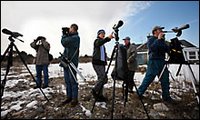
From the
Christian Science Monitor:
Birders keep lists. It's in their nature.
They keep lists of the total number of species catalogued in a lifetime. They keep North American lists. State lists. Neighborhood lists. Day lists. They keep "man powered" lists of the birds they've seen while on foot or bike. Some even keep lists of the species they've spotted mating.
To the uninitiated, it can be difficult to fathom the allure of bird-watching: It seems sleepy, a solitary hobby for retirees with too much time on their hands. But for a few, at least on certain days, bird-watching becomes a competitive sport - albeit one contested over an unusually large playing field.
...
It'll be interesting to see if this turns into a trend.
Digital camera and optics sales trends (Canada)
There's an interesting
press release out today on digital camera and optics sales in Canada. To make a long story short, digital cameras are crushing film cameras at a rapid pace. Binoculars and spotting scopes continue to plug along.
Wildlife watching in Yellowstone
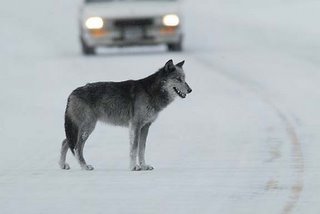
A report from the San Francisco Chronicle discusses wildlife watching in Yellowstone National Park:
The wolves were at our door -- almost literally.
They killed a big bull elk on the steps of the Mammoth Hot Springs Hotel dining room the night before we arrived. Now, as we crunched across the frozen parking lot in the predawn darkness, we could hear their not-so-distant howls.
Afraid? Enthralled was more like it. This is what we'd come for. Since their reintroduction here 11 years ago, Yellowstone National Park has become the premier venue in North America -- possibly in all the world -- for viewing wild wolves. To wildlife enthusiasts, they're a bigger attraction than Old Faithful.
It's possible to see them most times of the year, but winter is best -- especially February through April. (January is usually too cold). The wolves are more active during the day, their dark gray coats stand out against the white snow, and they follow their prey from the high country down to valley bottoms more easily accessible to humans.
Winter is also when Yellowstone is at its most beguiling. The geysers are more sharply etched as they erupt into the biting-cold air. The hot, sulfurous clouds billowing out of fumaroles and mud pots gain dramatic definition. Bison, their shaggy beards coated with snow, snort steam as they use their enormous heads as snowplows.
Free online astronomy course!
The
Planetary Society reports on a free 13 week astronomy course sponsored by California State University at Dominguez Hills.
"...The course, part of Cal State Dominguez Hills Young Scholar Distance Learning Program, will place a strong emphasis on planetary science, covering all the major bodies in our solar system, as well as stars, galaxies, the origins and evolution of the solar system and universe, and the possibility of life on worlds other than Earth. The first class on February 6 will begin with "Tour of the Solar System."
How has volcanism shaped our world and other planets? What are the effects of the solar wind? Why do the gas giants have ring systems? Each lesson will offer new topics and new insights, including how to gain "eyes-on" experience by doing night sky observations that are possible without the aid of a telescope. Experts from around the country will join Betts via videoconference and phone to describe their research and to take questions from students via phone and e-mail.
While students at Cal State Dominguez Hills who take the class for credit will be required to complete assignments and take exams, everyone interested in astronomy is encouraged to tune in for the sheer fun of learning -- no homework required! The class will be webcast from 3:00-4:00 PM PST and will air simultaneously on cable stations in southern California. Classes can be seen on channel 36 on cable television in the City of Los Angeles, Channel 6 in the South Bay, City View Channel 16 in Santa Monica, and Channel 64 in Pasadena. Television viewers will be given a toll-free number they can use to speak with the instructor during the live broadcast. After each lesson airs, it will be archived on the web site for the duration of the course (February 6- May 10, 2006)."
What to do with the new Christmas optics
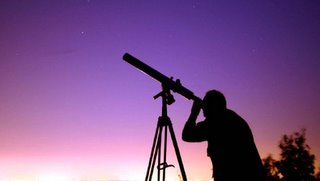
A
story from the UK discusses what to do with that new telescope/spotting scope/binoculars. Topics include the moon and planets. Click through for additional links.














